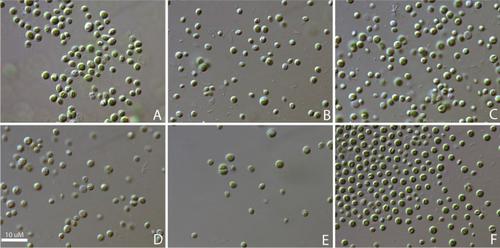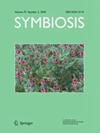淡水海绵棘藻的共生藻类
IF 2
3区 生物学
Q3 MICROBIOLOGY
引用次数: 0
摘要
淡水海绵(Ephydatia muelleri)是研究动物与微生物共生的新兴模式系统。胞内绿色微藻是一种较常见的共生体,生活在兼性共生与e.m uelleri。虽然这些共生体早已为人所知,但穆勒氏杆菌细胞中藻类共生体的身份尚未得到详细研究。在这里,我们从不同地理位置收集的穆勒氏杆菌中分离和表征了内共生藻类。我们发现藻类可以通过无性繁殖的小珠传播,重要的是它们可以在成体海绵中与不同的、分化的海绵细胞类型形成共生。我们的研究结果表明,至少有两种藻类谱系与muelleri e形成内共生。其中一个谱系包括在加拿大两个地点和美国一个地点的样本中常见的物种(进化支1:与pyrenoidosa Auxenochlorella密切相关)。另一个分支包括在美国缅因州一个地点的海绵中发现的藻类,以及Lewiniosphaera symbiontica,这是1956年从淡水海绵海绵中分离出来的一个菌株。我们比较了在微藻培养物和原始海绵宿主中发现的微生物组,发现这两个分支的细菌微生物组非常相似(在我们比较的样品中有91目细菌共享)。在培养物中发现的微生物组与海绵宿主的微生物组相似,并有高度重叠。本文章由计算机程序翻译,如有差异,请以英文原文为准。

Algal symbionts of the freshwater sponge Ephydatia muelleri
Abstract The freshwater sponge, Ephydatia muelleri , is an emerging model system for studying animal:microbe symbioses. Intracellular green microalgae are one of the more common symbionts that live in a facultative mutualism with E. muelleri . While these symbioses have long been known, the identity of the algal symbionts in E. muelleri cells has not been studied in detail. Here, we isolate and characterize endosymbiotic algae from E. muelleri collected from different geographic locations. We find that the algae can be transmitted through asexually produced gemmules and importantly that they can form symbioses with different, differentiated sponge cell types in the adult sponge. Our findings indicate that at least two algal lineages form endosymbioses with E. muelleri . One of the lineages includes species commonly found in samples from two locations in Canada and one in the United States (clade 1: closely related to Auxenochlorella pyrenoidosa ). The other clade includes algae found in sponges from one site in Maine, USA, and Lewiniosphaera symbiontica , which is a strain isolated in 1956 from the freshwater sponge Spongilla . We compared microbiomes found in cultures of microalgae as well as the original sponge hosts, and found that very similar bacterial microbiomes associate with both clades (91 orders of Bacteria are shared among the samples we compared). The microbiomes found in the cultures resemble, with a high degree of overlap, the microbiome associated with the sponge host.
求助全文
通过发布文献求助,成功后即可免费获取论文全文。
去求助
来源期刊

Symbiosis
生物-微生物学
CiteScore
4.80
自引率
8.00%
发文量
56
审稿时长
>12 weeks
期刊介绍:
Since 1985, Symbiosis publishes original research that contributes to the understanding of symbiotic interactions in a wide range of associations at the molecular, cellular and organismic level. Reviews and short communications on well-known or new symbioses are welcomed as are book reviews and obituaries. This spectrum of papers aims to encourage and enhance interactions among researchers in this rapidly expanding field.
Topics of interest include nutritional interactions; mutual regulatory and morphogenetic effects; structural co-adaptations; interspecific recognition; specificity; ecological adaptations; evolutionary consequences of symbiosis; and methods used for symbiotic research.
 求助内容:
求助内容: 应助结果提醒方式:
应助结果提醒方式:


